Please wait while we process your payment
If you don't see it, please check your spam folder. Sometimes it can end up there.
If you don't see it, please check your spam folder. Sometimes it can end up there.
Please wait while we process your payment
Get instant, ad-free access to our grade-boosting study tools with a 7-day free trial!
Learn more



This site is protected by reCAPTCHA and the Google Privacy Policy and Terms of Service apply.
Create Account
Select Plan
Payment Info
Start 7-Day Free Trial!

Annual
2-49 accounts
$22.49/year + tax
50-99 accounts
$20.99/year + tax
Select Quantity
Price per seat
$29.99 $--.--
Subtotal
$-.--
Want 100 or more? Request a customized plan
You could save over 50%
by choosing an Annual Plan!

SAVE OVER 50%
compared to the monthly price!
| Focused-studying | ||
| PLUS Study Tools | ||
| AP® Test Prep PLUS | ||
| My PLUS Activity | ||
$22.49/month + tax
Save 25%
on 2-49 accounts
$20.99/month + tax
Save 30%
on 50-99 accounts
| Focused-studying | ||
| PLUS Study Tools | ||
| AP® Test Prep PLUS | ||
| My PLUS Activity | ||
No Fear provides access to Shakespeare for students who normally couldn’t (or wouldn’t) read his plays. It’s also a very useful tool when trying to explain Shakespeare’s wordplay!
Erika M.
I tutor high school students in a variety of subjects. Having access to the literature translations helps me to stay informed about the various assignments. Your summaries and translations are invaluable.
Kathy B.
Teaching Shakespeare to today's generation can be challenging. No Fear helps a ton with understanding the crux of the text.
Kay H.
No Fear provides access to Shakespeare for students who normally couldn’t (or wouldn’t) read his plays. It’s also a very useful tool when trying to explain Shakespeare’s wordplay!
Erika M.
I tutor high school students in a variety of subjects. Having access to the literature translations helps me to stay informed about the various assignments. Your summaries and translations are invaluable.
Kathy B.
Teaching Shakespeare to today's generation can be challenging. No Fear helps a ton with understanding the crux of the text.
Kay H.
Create Account
Select Plan
Payment Info
Start 7-Day Free Trial!
You will only be charged after the completion of the 7-day free trial.
If you cancel your account before the free trial is over, you will not be charged.
You will only be charged after the completion of the 7-day free trial. If you cancel your account before the free trial is over, you will not be charged.
Order Summary
Annual
7-day Free Trial
SparkNotes PLUS
$29.99 / year
Annual
Quantity
51
PLUS Group Discount
$29.99 $29.99 / seat
Tax
$0.00
SPARK25
-$1.25
25% Off
Total billed on Nov 7, 2024 after 7-day free trail
$29.99
Total billed
$0.00
Due Today
$0.00
Promo code
This is not a valid promo code
Card Details
By placing your order you agree to our terms of service and privacy policy.
By saving your payment information you allow SparkNotes to charge you for future payments in accordance with their terms.
Powered by stripe
Legal
Google pay.......



Please wait while we process your payment

Sorry, you must enter a valid email address
By entering an email, you agree to our privacy policy.
Please wait while we process your payment

Sorry, you must enter a valid email address
By entering an email, you agree to our privacy policy.
Please wait while we process your payment

Your PLUS subscription has expired
Please wait while we process your payment
Please wait while we process your payment

The Concept of the Derivative
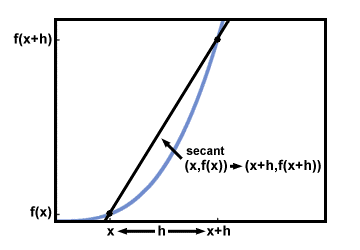
To get the slope of the curve at the point (x, f (x)), let's now draw the tangent line at (x, f (x)).
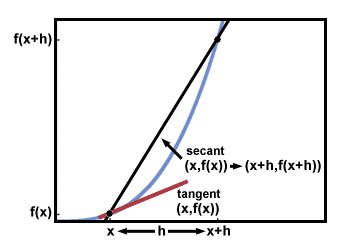
Recall that the tangent to the graph has the same slope as the graph at the point of tangency. Therefore, finding the slope of the graph at (x, f (x)) is the same as finding the slope of the tangent line we have just drawn.
Now comes a crucial step. Consider what happens to the secant line as h, the distance between the two points on the x-axis, is made progressively smaller:
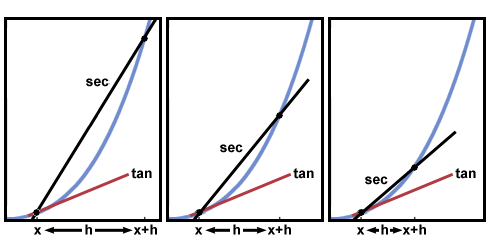
It appears now that as h gets smaller, the secant line looks more and more like the tangent line, which means that the slope of the secant is getting closer and closer to the slope of the tangent. This suggests that if we could make h arbitrarily small, the slope of the secant would get arbitrarily close to the slope of the tangent. Using limits, this idea could be represented as:
mtangent =  (msecant) (msecant) |
Substituting in the difference quotient for the slope of the secant yields
mtangent =   |
Since the slope of the tangent is the same as the slope of the graph at the
point of tangency, we can say:
slope off at(x, f (x)) =   |
This is one of the central ideas of all of calculus. The limit of the difference quotient is
such an important expression that it is given a name, the derivative, and is
represented by "f'(x)". Thus, we can say:
f'(x) =   |
is the derivative of the function f with respect to x.
The derivative gives the slope of the curve (also the slope of the tangent to the curve) at the point (x, f (x)). The derivative itself is also a function, because for every x value that it is given, it returns a value that is equal to the slope of the tangent to f at x.
An alternate notation for the derivative is the Leibniz Notation, when
 means "the derivative of whatever follows with the respect to x". Thus,
means "the derivative of whatever follows with the respect to x". Thus,
 means the derivative of f with respect to x, or
f'(x) =
means the derivative of f with respect to x, or
f'(x) =  means the derivative of y with respect to x. Since y
commonly means
f (x), this is usually the same as
means the derivative of y with respect to x. Since y
commonly means
f (x), this is usually the same as
  f f or f'(x) or f'(x) |
A function f is said to be differentiable at x = a if f'(a) exists. In other words, a function is differentiable at x = a if
  |
exists.
Intuitively, for a function to be differentiable, it needs to be both continuous and "smooth". What is meant by "smooth" is that there are no sharp turns in the graph.
Tangent lines can only be drawn to graphs in places where they are both continuous and smooth, as shown below:
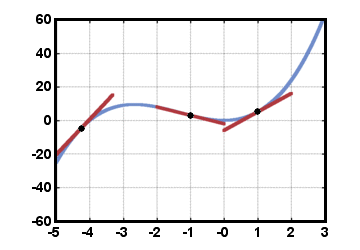
One example of a function that is continuous but not "smooth" throughout is the absolute value function. Consider f (x) =|x|. This function is continuous, but has a sharp "corner" at x = 0:
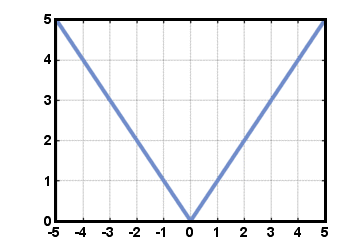
The function f (x) =|x| is not differentiable at x = 0 because the sharp corner makes it impossible to draw a single tangent line, since there is no defined slope there. Thus, f'(0) does not exist for this function.
Note that any differentiable function must also be continuous, since it is impossible to have a defined slope at a point of discontinuity. However, not all continuous functions are differentiable. An example of this was seen with the absolute value function.
Please wait while we process your payment





